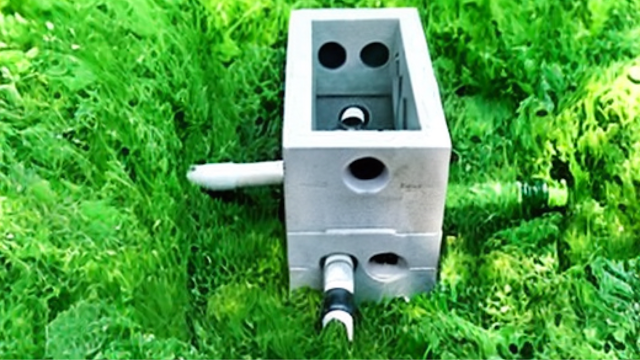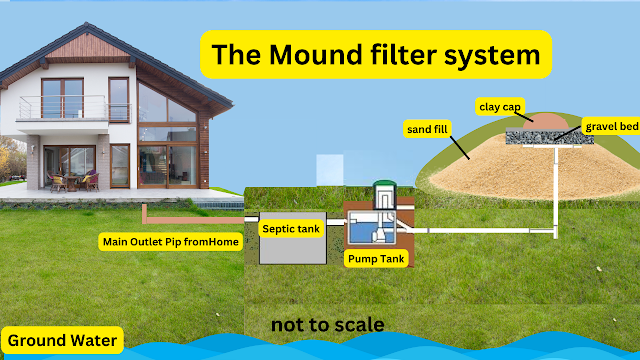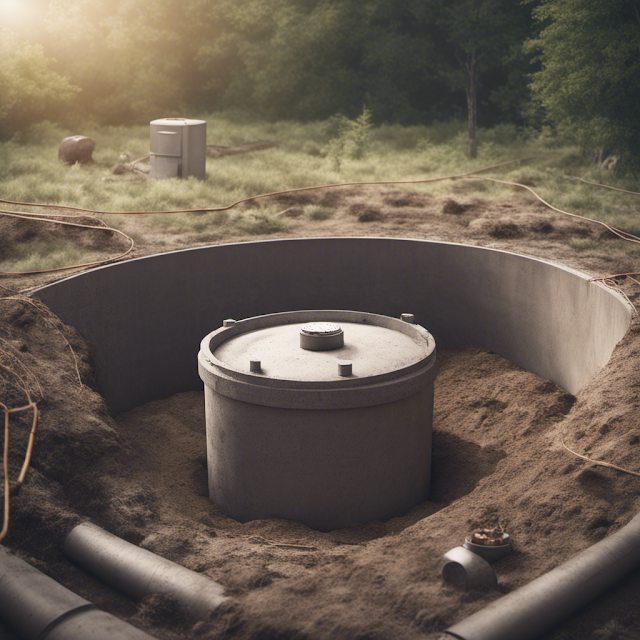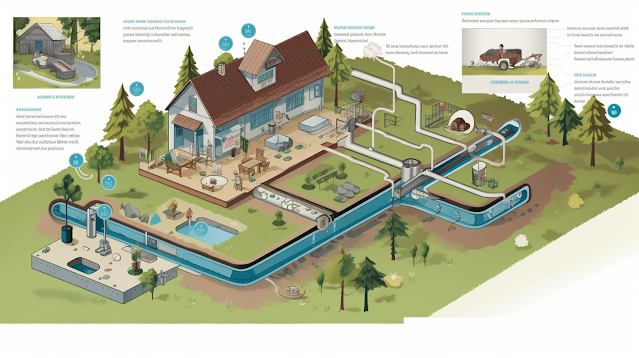Cesspit vs Septic Tank: What You're Not Being Told
Introduction
Waste disposal is an essential consideration for any property. There are many sewage system variations available, but the most common options are the septic tank and cesspit. Both storage options are used for waste storage and effluent collection, making them a popular choice for domestic properties and rural areas.
The comparison between cesspit and septic tank waste treatment and storage options range from discharge differences to the environmental impact of disposal. The main difference between them is that a cesspit is a holding tank without an outlet, meaning that it is for storage only, and there is no drainage or treatment of the effluent. In contrast, a septic tank offers a dual system of both treatment and storage, which collects waste from a property and separates solids and liquids. The liquids then discharge into a drainage field, while the solids remain in the tank and break down over time.
Maintenance and effluent disposal are crucial factors to consider when choosing between the two systems. Cesspit emptying and waste removal must be carried out regularly to avoid overflows and ensure compliance with cesspit regulations and environmental standards. On the other hand, a septic tank requires periodic pump-outs and drainage field maintenance to prevent the discharge of untreated liquids into nearby watercourses, causing waterway pollution.
In conclusion, understanding the characteristics and legal aspects of both cesspit and septic tank waste management systems is crucial. Choosing the right option will depend on specific property needs and budget, waste treatment options and sewage solutions required, and the legal requirements and environmental standards of the area.
Septic Tank Diagram
Cesspit vs. Septic Tank: What's the difference?
When it comes to waste disposal, there are a variety of sewage system variations to consider. Perhaps the most common systems are cesspits and septic tanks. Both perform the same function of waste storage, but differ in the way effluent is collected and discharged.
A cesspit is a holding tank without an outlet. It is a sealed sewerage system designed for storage only, with no drainage and no treatment of sewage. On the other hand, a septic tank is a dual system that allows for both treatment and storage of sewage.
In a septic tank, the waste is broken down by bacteria and filtered before being discharged into a drainage field. In contrast, a cesspit requires cesspit emptying periodically, where the accumulated waste is removed for treatment and disposal.
Another factor for comparison is effluent disposal and environmental impact. Septic tanks discharge the treated effluent into a drainage field where it is further treated by the soil. In contrast, cesspits require waste collection and transport for off-site treatment and disposal. Discharging directly into streams or watercourses will result in waterway pollution and significant environmental damage.
For maintenance, cesspits require regular cesspit emptying, ensuring it never gets too full and doesn't overflow. Septic tanks need occasional pumping to remove solids that never fully decompose.
Legal requirements and environmental standards should be in mind when choosing between a cesspit and septic tank, as is compliance. For instance, a holding tank without an outlet requires a permit to be granted from the Environment Agency.
In summary, the main difference between cesspits and septic tanks is storage and treatment. Cesspits only store the waste, while septic tanks treat it before discharge. When deciding which system to install, it is essential to evaluate the pros and cons of each option, their characteristics, waste removal requirements, and compliance.
How Does A Cesspit Work?
A cesspit, also known as a cesspool, is a type of underground waste storage tank that collects and stores wastewater from toilets, sinks, and appliances. Unlike septic tanks, which treat and discharge sewage effluent into a drainage field, a cesspit is only used for waste storage.
Here are the characteristics of a cesspit system:
Waste Storage Only
The primary function of a cesspit is to store waste until it is removed by a waste removal company. Cesspits do not have any treatment process, and effluent is not discharged into a drainage field or watercourse. This means that cesspits require more frequent emptying than septic tanks, typically every few weeks to several months, depending on the tank's size and the level of usage.
No Drainage Field
A cesspit does not have a drainage field like septic tanks. Without a drainage field, effluent cannot be treated naturally, resulting in larger volumes of waste requiring frequent waste removal. Most cesspits have limited storage capacity, and once the tank is full, the waste removal process must occur more regularly.
Environmental impact
Cesspits have a considerable environmental impact if not properly maintained. Effluent is often collected and taken to a waste treatment plant for disposal as it is not suitable for discharge in watercourses. Effluent disposal must occur regularly to prevent negative environmental effects like pollution of watercourses.
Cesspit Regulations
Cesspits are regulated under environmental law. You must comply with legal requirements and environmental standards when installing, using, and maintaining a cesspit system.
Cesspit Features
A cesspit can come in various shapes and sizes. It is made of concrete rings or fiberglass, which ensures no sewage leaks from the tank. The top is fitted with a sealed cover that is designed to prevent odors from escaping.
Maintenance
Maintaining a cesspit requires a regular cleaning and disposal of the collected waste. The use of chemicals and bleach should be avoided as they may damage the tank. The tank should be inspected regularly and emptied by a professional cesspit emptying company.
Cesspit Vs. Septic Tanks
While both systems collect waste, a cesspit is only used for waste storage and requires more frequent emptying and regular maintenance. A septic tank, however, has a treatment process that discharges wastewater into a drainage field.
System Comparison
The table below summarizes the differences between a cesspit and septic tank:
In conclusion, knowing the differences between cesspits and septic tanks is essential when deciding which system to choose. A cesspit is primarily used when it is not possible to discharge sewage effluent into a drainage field. It is important to follow necessary regulations, carry out regular maintenance and waste removal, and avoid damaging the tank. A septic tank is generally more suitable for homes or businesses that have sufficient land to install discharge options.
How Does a Septic Tank Work?
A septic tank is a type of waste disposal system that treats sewage using natural processes. Waste from toilets, sinks, and other sources flows into a septic tank, which is usually buried underground. Once inside the tank, the solids settle to the bottom forming a sludge layer, whereas the liquids float to the top forming a scum layer. The septic tank is designed to hold both the sludge and scum layers whilst enabling the liquids to flow into a secondary treatment system such as a drainage field, where they can be further treated and dispersed.
The main difference between a septic tank and cesspit is that a cesspit is just a waste storage unit, while a septic tank acts as both a waste storage unit and sewage treatment system. A septic tank serves as a primary treatment unit, whereas a cesspit only stores sewage until it is removed by waste removal trucks.
A septic tank is made up of several chambers, connected by pipes, each serving a specific purpose in the waste treatment process. The first chamber of the tank receives sewage from the pipes, where the solids and liquids are separated. The settled solids are broken down by bacteria, and the liquids are allowed to flow into the next chamber for further sewage treatment. Ultimately, the wastewater is disposed of in the drainage field, where the surrounding soil acts as a natural filter, purifying the water and preventing waterway pollution.
A key factor that sets septic tanks apart from cesspits is their discharge to the environment. The septic tank system ensures that effluent discharged into streams or watercourses is clean and free of contaminants, making them a more environmentally friendly option.
Maintenance and proper cesspit or septic tank emptying are essential in compliance with legal requirements. Failure to do so may result in failing environmental standards, which can lead to waterway pollution and other environmental impacts.
In summary, septic tanks are an effective waste treatment option for homes and properties without access to a public sewage system. These are regulated by legal guidelines to protect the environment and public health. They are cost-effective, eco-friendly and promote sustainable sanitation. Understanding the differences between various sewage systems and adhering to their respective regulations is essential for efficient waste disposal and environmental preservation.
Costs and Maintenance for Cesspits
Cesspits are a common solution for waste storage and effluent collection, but how do they compare to septic tanks in terms of cost and maintenance? In this section, we will explore the differences and similarities between the two systems.
Cost Comparison
When it comes to cost, cesspits are generally cheaper to install than septic tanks since they require no drainage field or sewage treatment. However, cesspits have to be emptied more frequently than septic tanks, which could lead to increased costs in the long run. On average, a cesspit requires emptying every 45-90 days, whereas a septic tank can go up to 3-5 years without emptying.
Maintenance
Cesspits are a low-maintenance option that is simply used for storing waste. Unlike septic tanks, they require no treatment or discharge to ground. However, as mentioned earlier, regular emptying is required to avoid overflow, which could lead to environmental issues like waterway pollution. On the other hand, a septic tank needs little maintenance, but the drainage field needs regular inspection and maintenance.
Legal Requirements and Environmental Standards
It's essential to note that both septic tanks and cesspits must comply with regulations and environmental standards. Cesspits are often subject to more stringent regulations since they hold sewage without any form of treatment, i.e., no filtration or biological breakdown of waste. Therefore, they require regular emptying to avoid environmental hazards. Septic tanks, on the other hand, can discharge effluent to streams or watercourses if correctly installed and maintained.
Cesspit Characteristics
Cesspits are simple holding tanks without an outlet, whereas septic tanks are usually installed with a drainage field to absorb and treat the effluent. Therefore, cesspits are ideal for sites with poor drainage or limited space for treatment. Cesspits are also a common option for temporary use, construction sites, or areas where effluent disposal is difficult due to the location. In contrast, septic tanks are designed for long-term use and require a suitable drainage field for discharge.
Cesspit Emptying, Waste Removal, and Effluent Disposal
Cesspit emptying and waste collection are crucial maintenance tasks that ensure the system functions correctly. It would be best if you emptied the cesspit regularly to prevent environmental hazards. The collected waste and effluent must be disposed of appropriately, following regulations and environmental standards. Cesspit regulations vary by state, so it's essential to research and follow local laws to avoid penalties.
In conclusion, both septic tanks and cesspits have their pros and cons. The choice between the two depends on your specific requirements and site conditions. While cesspits are cheaper to install and simpler to maintain, the cost of frequent emptying may outweigh the initial savings. Septic tanks, on the other hand, require less frequent emptying but have higher installation and maintenance costs. It's critical to consult with a professional to determine the best option for your needs and comply with legal requirements and environmental standards.
Costs and Maintenance for Septic Tanks
Maintaining a septic tank is crucial to ensuring efficient and effective waste disposal. A well-maintained septic tank can serve a household for many years without issues. This section will cover the cost and maintenance requirements for septic tanks, in comparison to cesspits.
Cost Comparison
The initial cost of septic tanks is typically higher than that of cesspits due to the combination of a holding tank and a drainage field system. However, considering the long-term benefits, septic tanks are usually a more cost-effective option than cesspits.
The cost of maintenance for septic tanks is also relatively low compared to cesspits. Septic tanks require less frequent emptying than cesspits, and the process of emptying is more straightforward. Therefore, the frequency of maintenance will depend on the size of the tank and the number of occupants in the household.
Maintenance Requirements
To keep a septic system operating optimally, care should be taken when it comes to what enters the system. For example, excessive use of bleach, detergents, and oils can interfere with the biological process of the tank and cause harm to the environment.
There are no complex maintenance requirements for septic tanks, but regular inspections by a professional, usually every three to five years, will help identify potential issues and prolong the lifespan of the system.
On the other hand, cesspits require frequent emptying, every 45-90 days, depending on the usage. The cost of emptying cesspits is relatively high due to the complex process of removing and treating the waste. Therefore, cesspit owners should factor the regularity and costs of emptying when making their decision.
Environmental Impact
While both septic tanks and cesspits have a capacity to store waste, septic tanks offer a superior sewage treatment solution. Septic tanks typically discharge effluent into a drainage field where further treatment and purification occurs naturally before discharging to streams or watercourses.
In comparison, cesspits only offer storage, and effluent disposal requires regular tank emptying. This means that poorly maintained cesspits are more likely to discharge untreated effluent into watercourses, causing waterway pollution and posing a risk to sanitation and public health.
Conclusion
Septic tanks are a more cost-effective and environmentally-friendly option of the two. In terms of maintenance, the complexity and costs of cesspits make septic tanks the better solution. Compliance with legal requirements and environmental standards can be achieved more easily with septic tanks, and they offer an efficient and reliable means of treating sewage for years to come.
Which is better for the environment?
When deciding between a cesspit and a septic tank, it's important to consider their environmental impact. Both systems have their pros and cons, and this section will highlight the differences between the two in terms of waste disposal and environmental impact.
Waste disposal
A cesspit is a waste storage system that doesn't have a drainage field or outlet. It's simply a holding tank, and the effluent collection requires regular cesspit emptying by a waste removal service. On the other hand, a septic tank is a dual system that combines waste storage with sewage treatment and drainage. It discharges treated effluent to a drainage field, which allows the effluent to be dispersed into the surrounding soil.
Environmental impact
While both systems can be effective in their own right, the discharge difference is the most significant factor when considering their environmental impact. A cesspit is a sealed sewerage system that doesn't treat or discharge any effluent. It's designed for storage only and requires regular waste collection for effluent disposal. In contrast, a septic tank is an enclosed disposal and waste treatment system that disperses treated effluent into the surrounding soil. However, if a septic tank is not regularly maintained or if the drainage field is improperly constructed, the effluent may discharge to streams or watercourses, causing waterway pollution.
Compliance and regulation
Both septic tanks and cesspits must comply with environmental standards and legal requirements for sewage disposal, effluent gathering, and sanitation. Cesspit regulations require regular cesspit emptying and maintenance to ensure proper waste removal and effluent disposal. In contrast, septic tanks require regular maintenance and proper construction of the drainage field to ensure the effective treatment and storage of waste.
System comparison
When it comes to waste treatment options, a septic tank is a more comprehensive system than a cesspit. It treats waste and disperses treated effluent into the surrounding soil, while a cesspit is solely for waste storage. A holding tank without an outlet, such as a cesspit, may be suitable for sites where there is no viable drainage field location. The cesspit feature of sealed sewerage systems is an option for sites that require waste storage only, with no provision for drainage.
In conclusion, when considering which system is better for the environment, a septic tank is generally the better option. It effectively treats and disperses effluent, while a cesspit requires regular waste collection and has the potential to cause waterway pollution if not managed properly. However, both systems must comply with environmental standards and legal requirements for effluent disposal and sanitation, with regular maintenance and proper construction of drainage fields being vital for septic tank systems. Ultimately, the choice of system will depend on site conditions and the type of waste treatment and storage required.
Which is better for rural areas?
When it comes to waste disposal in rural areas, there are a few sewage treatment options to consider. In this section, I'll compare cesspits and septic tanks to determine which one is better suited for rural areas.
A cesspit is a waste storage system that doesn't have an outlet or drainage field, which means it needs to be emptied regularly. On the other hand, a septic tank is a sewage system variation that allows for both treatment and storage of waste before it's discharged to streams or watercourses.
The primary difference between the two systems is the way effluent disposal occurs. A cesspit gathers effluent and requires regular cesspit emptying by a licensed company for waste removal. Conversely, a septic tank system has an effluent collection and a drainage field, allowing for partial treatment of the waste before it's discharged.
In areas with regulations that require environmental standards, having a septic tank system may be more compliant than a cesspit. Cesspit regulations may be less strict, and there may be fewer legal requirements. As such, a cesspit may be a lower-cost option as it doesn't require a drainage field or other additional features.
When it comes to the environmental impact, waterway pollution is a significant concern with cesspits and septic tanks. A cesspit, being a sealed sewerage system, has enclosed disposal, making it a better option for odor control and avoiding contamination than septic tanks in some cases.
A combined storage system, such as a holding tank without an outlet, is another option for effluent collection and storage. A holding tank doesn't feature a Cesspit, has no drainage field, and only serves to store waste. Holding tanks are an excellent option for areas where there are no other sewage disposal options.
In terms of maintenance, a cesspit requires more frequent cesspit emptying or waste collection than a septic tank, which needs less intervention. However, the maintenance costs are often lower for a cesspit system than a septic tank as the latter has a more complex design.
In conclusion, while it may seem that a cesspit is an affordable and low-maintenance option, a septic tank system may be the better choice in rural areas. Septic tanks offer treatment and storage options, allowing for partial treatment of waste, which is better for the environment. Decisions regarding cesspit vs septic tanks may vary depending on regulations in each location, individual needs, and cost considerations.
Conclusion:
Overall, both septic tanks and cesspits have their advantages and disadvantages. Septic tanks provide efficient waste disposal and are more suited for properties with land to accommodate the necessary drainage field. However, they require regular maintenance and may not be suitable for certain types of soil.
On the other hand, cesspits are a reliable waste storage solution for those who lack the space for a septic tank's drainage field or cannot discharge to streams or watercourses. They eliminate the need for a drainage field, but require frequent cesspit emptying and waste removal.
When deciding between the two, a comparison of sewage system variations should be considered, including the dual system, combined storage, and treatment and storage options. Based on the effluent disposal and environmental impact, one can determine which option meets the necessary environmental standards and legal requirements.
It's important to note that a holding tank without an outlet, also known as a cesspit, is a feature that is designed solely for waste storage without a discharge difference. The storage-only feature of the cesspit has specific characteristics that make it different from a septic tank. A sealed sewerage system, enclosed disposal or sealed waste management may be preferred for sanitation purposes when compared to an open system.
Whether it's a septic tank or a cesspit, proper maintenance is crucial to ensure their efficiency and minimize the risk of waterway pollution or environmental impact. Effluent collection, waste disposal, and effluent gathering should be done in compliance with regulations and environmental standards.
In conclusion, understanding the differences between septic tanks and cesspits is important in making the right choice for your property's waste disposal needs. With proper management and compliance with legal requirements and environmental standards, either option can provide a reliable and effective sewage solution.


.png)



.png)






Comments
Post a Comment